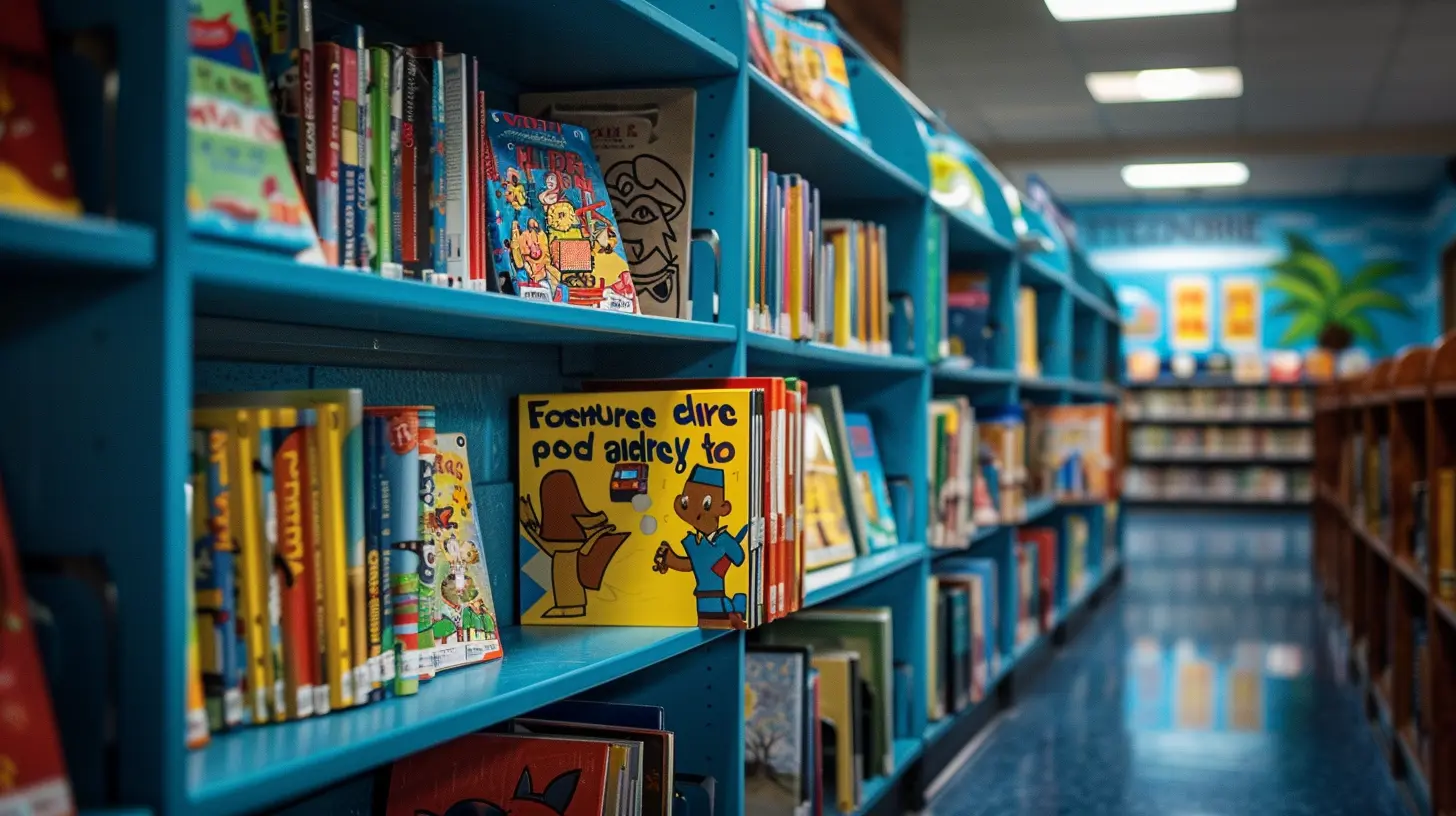Differentiation in Literacy Instruction: Helping Readers at All Levels
10 December 2024
Literacy is one of those fundamental skills that opens doors to endless opportunities. Whether you're a teacher, a parent, or someone passionate about education, you know how important it is to help students become confident and capable readers. But here's the catch: not all readers are the same. Some are flying through chapter books, while others might still be struggling with basic phonics. So, how do we meet the diverse needs of all learners? The answer lies in differentiation in literacy instruction.
In this article, we’ll explore what differentiation in literacy instruction looks like, why it’s essential for helping readers at all levels, and how educators can implement these strategies effectively. Buckle up because we’re about to dive deep into the world of differentiated instruction!

What is Differentiation in Literacy Instruction?
Before we get into the nitty-gritty details, let’s start with the basics. Differentiation in literacy instruction means tailoring your teaching methods to accommodate the varied needs, interests, and abilities of your students. Think of it as customizing a suit — one size definitely does not fit all.At its core, differentiation is about flexibility. It involves modifying content, process, product, and the learning environment to ensure that every student, regardless of their reading level, can engage with the material and make progress.
The Four Pillars of Differentiation
1. Content – What students need to learn and how they access the information.2. Process – How students make sense of the information.
3. Product – How students demonstrate what they’ve learned.
4. Learning Environment – The physical and emotional climate in which learning takes place.
By adjusting these four elements, teachers can create a more personalized learning experience that meets the unique needs of each student.

Why Is Differentiation Important in Literacy Instruction?
Imagine being in a classroom where everyone is expected to read the same book at the same pace. For some students, that book might be way too easy, causing them to lose interest and disengage. For others, it might be too difficult, leading to frustration and a sense of failure. Neither scenario promotes effective learning.Differentiation is the key to avoiding these pitfalls. It ensures that all students are challenged appropriately, but not overwhelmed. When done well, differentiation can:
- Boost student confidence: By providing texts and assignments that match students' reading levels, they can experience success, which naturally fuels their confidence.
- Enhance engagement: Students are more likely to stay engaged when the material is relevant, interesting, and pitched at the right level.
- Foster a growth mindset: Differentiation allows for mistakes and learning at one's own pace, encouraging students to see challenges as opportunities for growth rather than roadblocks.
- Improve outcomes: When instruction is tailored to individual needs, students are more likely to make progress and achieve their literacy goals.

Key Strategies for Differentiating Literacy Instruction
Now that we know why differentiation is essential, let’s explore some practical strategies you can use to help readers at all levels.1. Flexible Grouping
One of the most effective ways to differentiate literacy instruction is through flexible grouping. This involves grouping students based on their current reading levels, interests, or specific skills they need to work on. The groups should be fluid, meaning students can move between them as they make progress.How It Works:
- Group by ability: Create small groups of students who are at similar reading levels, and assign texts that are appropriate for their abilities.- Group by interest: Let students choose books or topics they are passionate about. Reading something they enjoy can work wonders for motivation.
- Group by skill: Focus on specific skills like phonics, comprehension, or fluency, and group students who need reinforcement in those areas.
The key here is flexibility. Don’t pigeonhole students into one group for the entire year. As they grow and develop, their group assignments should evolve too.
2. Tiered Assignments
Not all students need the same level of difficulty in their assignments. Tiered assignments allow you to provide different students with different tasks, all of which lead to the same ultimate goal.How It Works:
- For students who need more support, offer simpler texts with guided comprehension questions.- For students who are reading at grade level, provide more challenging texts and ask them to analyze the material more deeply.
- For advanced readers, assign complex texts and encourage independent projects that require critical thinking skills.
By offering tiered assignments, you ensure that all students are working on tasks that are appropriate for their skill level.
3. Leveled Texts
Not every student in your classroom can handle “War and Peace,” and that’s okay. Leveled texts are books or reading materials that are graded based on their complexity. This allows you to assign different texts to different students, ensuring they are reading material that matches their ability.How It Works:
- Use a tool like the Fountas & Pinnell system or Lexile levels to find books at each student’s reading level.- Provide a range of texts on the same topic but at different levels of difficulty. This way, all students can engage in discussions about the same subject, even if they’re reading different books.
- Ensure that lower-level texts are still age-appropriate. Just because a student is reading at a lower level doesn’t mean they should be stuck with “baby” books.
4. Scaffold Instruction
Scaffolding is like giving students training wheels until they’re ready to ride the bike on their own. It involves providing temporary support to students as they learn new skills, gradually removing those supports as they become more independent.How It Works:
- Start by modeling a reading strategy, like making predictions or summarizing.- Provide guided practice where students can try out the strategy with your help.
- Slowly shift responsibility to the students, allowing them to practice independently with minimal support.
Scaffolding is particularly useful for struggling readers who need more explicit instruction and guidance before they can tackle texts on their own.
5. Incorporate Technology
We’re living in the 21st century, so why not leverage technology to differentiate literacy instruction? There are tons of apps and online platforms that can provide personalized reading practice, track student progress, and offer engaging, interactive experiences.How It Works:
- Use apps like Epic! or Raz-Kids to provide students with access to leveled books that they can read at their own pace.- Try tools like Newsela, which offers news articles at various reading levels so all students can read about current events.
- Use audiobooks to support struggling readers who may benefit from hearing the text while following along.
Technology can be a game-changer, especially for students who need extra support or motivation.
6. Offer Choice
Students are much more likely to engage in reading when they feel like they have some control over what they’re reading. Offering choice is a simple but powerful way to differentiate instruction and keep students motivated.How It Works:
- Let students choose between several different books that fit their reading level.- Allow students to choose how they want to demonstrate their understanding of a text. Some might prefer writing a report, while others might enjoy creating a visual presentation or acting out a scene from the book.
- Give students options for reading independently, with a partner, or in a small group.
When students have a say in what they’re doing, they’re more likely to take ownership of their learning.

Overcoming Challenges in Differentiation
Differentiation sounds great, but let’s be real — it’s not always easy. Time constraints, limited resources, and the sheer diversity of students’ needs can make it challenging to differentiate instruction effectively. But don’t worry, there are ways to overcome these hurdles.1. Start small: You don’t have to differentiate every single lesson from day one. Start by trying out one or two strategies, like flexible grouping or leveled texts, and gradually build from there.
2. Use peer support: Encourage students to work together in mixed-ability groups. Higher-level readers can help their peers, and teaching others is a great way for advanced students to deepen their understanding.
3. Plan ahead: Differentiation requires thoughtful planning. Take time to assess your students’ needs and plan lessons that offer multiple entry points.
4. Be patient: Differentiation is a learning process for both you and your students. It might not be perfect at first, but with persistence, you’ll start to see progress.
Conclusion: A Classroom for Every Reader
Differentiation in literacy instruction isn’t just a buzzword — it’s a practical, effective approach to helping readers at all levels succeed. By using strategies like flexible grouping, tiered assignments, leveled texts, scaffolding, and incorporating technology, educators can create a learning environment that meets the diverse needs of their students.Remember, the goal isn’t to make every student the same. It’s to help each student grow, learn, and thrive at their own pace. After all, every reader is on their own unique journey, and with the right support, they can all reach their destination.
all images in this post were generated using AI tools
Category:
Differentiated InstructionAuthor:

Olivia Chapman
Discussion
rate this article
17 comments
Zayne McFarland
Great insights! Differentiation truly empowers every reader's journey!
February 1, 2025 at 8:56 PM

Olivia Chapman
Thank you! I'm glad you found the insights valuable. Differentiation really is key to supporting all readers!
Charlotte Rhodes
Embracing differentiation empowers every reader to thrive, fostering a love for literacy that transcends challenges and ignites potential!
January 30, 2025 at 1:00 PM

Olivia Chapman
Thank you for your insightful comment! Embracing differentiation truly unlocks the potential in every reader and cultivates a lifelong love for literacy.
Wren Thornton
This article beautifully highlights the importance of tailored instruction, nurturing every student's unique literacy journey with understanding and support.
January 26, 2025 at 5:46 AM

Olivia Chapman
Thank you! I'm glad you found the article emphasizes the crucial role of tailored instruction in supporting each student's literacy journey.
Julian McClellan
This article beautifully highlights the importance of differentiated instruction in literacy. It's inspiring to see strategies that support all readers, fostering a love for learning at every level!
January 23, 2025 at 3:31 AM

Olivia Chapman
Thank you for your kind words! I'm glad the article resonated with you and emphasized the value of differentiated instruction in fostering a love for literacy.
Gwen McLanahan
Ah, differentiation in literacy! It’s like a buffet where every reader finds their favorite dish—whether they’re nibbling on picture books or devouring epic novels. Just remember: not everyone is ready for the ‘spicy’ chapters, so let’s serve up some mild options too!
January 18, 2025 at 9:43 PM

Olivia Chapman
Absolutely! Just as a buffet accommodates various tastes, differentiation ensures all readers find engaging materials that suit their individual levels and preferences. Great analogy!
Alisha Warren
Empowering every reader's journey, tailored paths ignite a love for literacy's dance.
January 11, 2025 at 5:17 AM

Olivia Chapman
Thank you! Tailoring literacy paths indeed fosters a deeper connection to reading for all learners.
Lennox McVicker
Ah, differentiation in literacy! It's like trying to teach a cat to fetch—each reader is unique and has their own pace. Let's embrace the chaos and remember: even the slowest reader eventually catches the string—hopefully before it’s time for lunch!
January 6, 2025 at 1:10 PM

Olivia Chapman
Absolutely! Embracing the unique journeys of each reader is key to effective differentiation in literacy. Just like cats, every learner has their own pace, and with patience, they all make progress!
Kimberly Roth
Great insights on tailoring literacy instruction to support diverse reading levels effectively!
January 2, 2025 at 2:06 PM

Olivia Chapman
Thank you! I appreciate your feedback and am glad you found the insights helpful!
Xylo McMurtry
Great insights! Differentiation truly makes a difference in reaching every reader. Excited to implement these strategies in my classroom!
December 27, 2024 at 5:12 AM

Olivia Chapman
Thank you! I'm glad you found the insights valuable. Best of luck implementing these strategies in your classroom!
Julian West
Teaching kids to read is like feeding them spaghetti—some twirl it, others slurp it, and a few wear it as a hat! Let’s embrace every unique approach to literacy so every reader can find their flavor of learning. Bon appétit!”
December 24, 2024 at 11:48 AM

Olivia Chapman
Absolutely! Embracing diverse strategies in literacy instruction allows every child to engage with reading in their own way, making the learning process both effective and enjoyable. Bon appétit indeed!
Angie Stewart
Great insights on differentiation in literacy! Tailoring instruction to meet diverse needs truly empowers all learners. Every reader deserves support that fosters growth and confidence. Keep inspiring change in education!
December 22, 2024 at 9:14 PM

Olivia Chapman
Thank you for your kind words! I'm glad you found the insights valuable. Empowering all learners is essential for fostering growth in literacy.
Tia McNeil
Great article! It's inspiring to see such thoughtful approaches to literacy instruction. Differentiation truly unlocks potential for all readers. Remember, every small step in helping students connect with texts can lead to significant progress. Keep fostering those love-for-reading moments! 📚✨
December 20, 2024 at 8:05 PM

Olivia Chapman
Thank you for your kind words! I'm glad you found the article inspiring. Every small step truly makes a difference in fostering a love for reading! 📚✨
Leslie McCracken
Differentiation in literacy instruction is crucial for addressing the diverse needs of students. By tailoring strategies to various skill levels, educators can foster a more inclusive learning environment. Effective differentiation not only enhances reading proficiency but also promotes a love for reading among students at all stages of development.
December 15, 2024 at 9:13 PM

Olivia Chapman
Thank you for your insightful comment! I completely agree that effective differentiation in literacy instruction is key to supporting diverse learners and cultivating a passion for reading.
Vireo McMeekin
This article is a gem! Embracing differentiation in literacy truly makes a world of difference, ensuring every reader finds their path to success!
December 12, 2024 at 4:43 AM

Olivia Chapman
Thank you for your kind words! I'm glad you found the article valuable in highlighting the importance of differentiation in literacy.
Aisha Wright
What a delightful read! Your insights on differentiation in literacy are not just helpful; they're inspiring! Every reader deserves a path to success, and your strategies empower educators to nurture each child's unique journey. Keep sharing the magic of reading!
December 11, 2024 at 8:27 PM

Olivia Chapman
Thank you so much for your kind words! I'm thrilled to hear that you found the insights inspiring. Together, we can create a world where every child thrives in their literacy journey!
Summer Hahn
This article effectively highlights essential strategies for differentiating literacy instruction, ensuring that educators can support and engage readers across all proficiency levels.
December 10, 2024 at 9:34 PM

Olivia Chapman
Thank you for your feedback! I'm glad you found the strategies helpful for supporting diverse readers.
Zylith Allen
Thank you for this insightful article! Your strategies for differentiation in literacy instruction are invaluable for meeting diverse student needs effectively.
December 10, 2024 at 5:39 AM

Olivia Chapman
Thank you for your kind words! I'm glad you found the strategies valuable for addressing diverse student needs.
MORE POSTS

Designing Curriculum for Multilingual Learners: Best Practices

The Role of Gamification in Virtual Learning Spaces

How Virtual Classrooms are Revolutionizing Special Education

How to Manage Non-Verbal Cues in Video Meetings

Collaborative Learning: Encouraging Teamwork in the Classroom

The History of Empires: Power, Expansion, and Decline

The History of Education: From Plato’s Academy to Today’s Schools

Differentiating Instruction in Art and Music Classrooms

Aligning Curriculum with Modern Learning Standards

How to Use Technology to Enhance Your Study Plan

The Role of Parental Support in Student Motivation